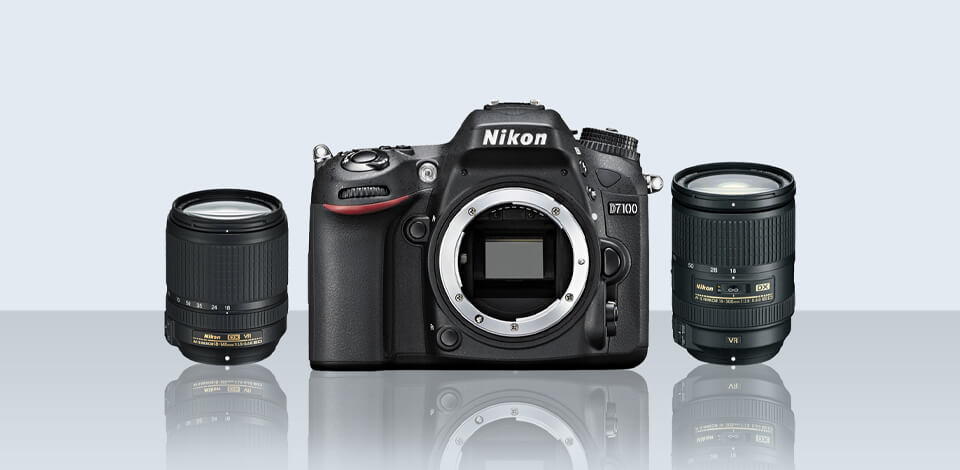
I'm a photographer at FixThePhoto, so many people often ask me which lenses are the best for the Nikon D7100. This camera is still popular among both new and experienced photographers, so I decided to write a clear and helpful guide. A lot of our readers have the same questions: should they buy one lens that can do everything or a few that are made for special uses? Which lenses are best for portraits or close-up (macro) shots? And how do lenses made by other brands compare to Nikon’s own lenses?
To find the answers, I did a lot of research. I read reviews on Reddit, Amazon, Quora, and YouTube, and I also talked with my coworkers. Together with the FixThePhoto team, we tested over 30 Nikon D7100 lenses. We tried them for portraits, landscapes, wildlife, and close-up photos. We looked at many factors: how sharp the images were, how fast and quiet the autofocus was, how well the lenses worked in low light, how strong the build quality felt, and how much they cost, from cheaper beginner lenses around $197 to high-end professional ones.
 ★★★★★ (5/5) Nikon AF-S DX NIKKOR 18-140mm f/3.5-5.6G
★★★★★ (5/5) Nikon AF-S DX NIKKOR 18-140mm f/3.5-5.6G
This is one of the best lenses for the Nikon D7100, because it has a wide zoom range for both wide-angle to telephoto shots, produces sharp pictures, and focuses fast and quietly with its Silent Wave Motor. It’s made for DX cameras like the D7100, so it fits perfectly and works well for daily photos, travel, and portraits.
After testing many lenses on the Nikon D7100, I noticed that not all of them perform the same. Knowing which lenses are compatible with your camera is very important if you want the best results. Here’s what I found and some advice from my experience:
Tips for choosing lenses:
Understanding lens abbreviations helps you know what each lens can do. Here’s a short guide:
Knowing these short forms made it easier for me to choose the right lens for different types of photos (portraits, landscapes, or macro shots).
Amazon: 200+ bought in the past month
B&H: 100+ sold in the past year
Adorama: 200+ sold in the past year
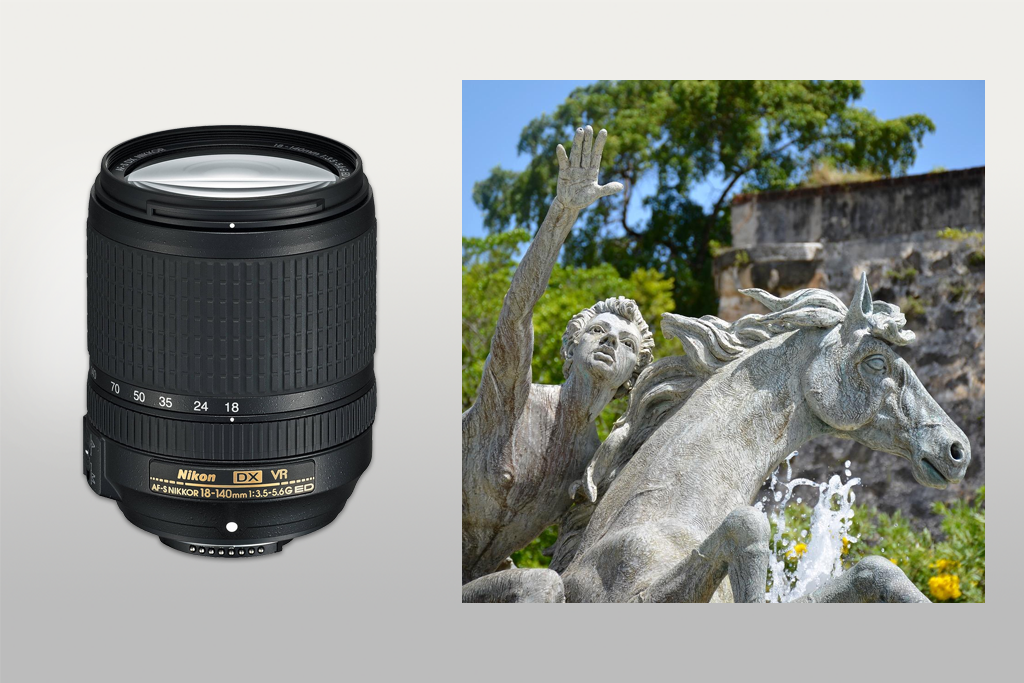
Lens Type: Zoom | Focal length: 18-140mm | Aperture: f/3.5 to f/38 | VR: Yes | Weight: 490g
Best for: Travel, everyday shooting, events, casual portraits, family photos. It covers wide (18mm) to medium telephoto (140mm) so you can use it as a “one-lens solution.”
The Nikon AF-S DX NIKKOR 18-140mm f/3.5-5.6G ED VR is a great all-purpose lens for the Nikon D7100. When I tested it, I used it for many kinds of photos – street scenes, outdoor portraits, travel views, and even quick product pictures. The zoom range from 18mm to 140mm makes it very flexible. It can take wide shots of cities or rooms and also zoom in close for portraits or faraway subjects.
One thing I liked a lot was the Vibration Reduction (VR) feature. It helped me take clear photos even when holding the camera by hand, especially when zooming in to 100–140mm or shooting in low light. The autofocus was fast and quiet because of Nikon’s Silent Wave Motor, which also worked nicely for video. The colors looked good, and the sharpness stayed strong through most of the zoom range.
But there are a few downsides. This Nikon lens is not very light, so carrying it for many hours can get tiring. At the widest setting, I saw some barrel distortion, and sometimes shadows appeared when using the built-in flash. Also, compared to Nikon’s prime lenses, the photos weren’t as colorful or bright in darker places.
When Vadym tested this lens, he looked closely at how it felt to use. He found the zoom ring a bit stiff, but liked that there was no zoom creep, which is great for travel and video. He also noticed that the focus worked smoothly and didn’t struggle much, even indoors.
Amazon: 100+ bought in the past month
eBay: 200+ sold in the past year

Lens Type: Zoom | Focal length: 18-300mm | Aperture: f/3.5 to f/38 | VR: Yes | Weight: 830g
Best for: Travel, vacations, safaris, when you don’t want to swap lenses. With its extreme zoom range, you can shoot wide landscapes at 18mm and reach distant wildlife or sports at 300mm.
I tested the Nikon 18-300mm f/3.5-5.6G ED VR for travel, portraits, landscapes, and wildlife. The zoom range is very wide, letting me move from big city views to close-up shots of birds within seconds. The VR II system helped me take clear handheld shots even at 300mm, and the autofocus was fast and quiet, great for both photos and videos.
What I liked most was the freedom of not needing to change lenses. When I traveled, I could take pictures of a large building at 18mm, then zoom in to focus on details or birds far away at 300mm. The VR II worked very well – even when using slower shutter speeds, my handheld shots stayed sharp. The autofocus was smooth and silent, which helped when shooting video.
However, since this lens is big and heavy, it’s not as easy to carry all day. At 18mm, I saw some barrel distortion and a slight “fisheye” look, but the D7100’s auto correction fixed most of it. When Vadym tested this wide-angle lens, he focused on sharpness and handling, and he said it performed best in the mid-range (50-200mm), which is where many photographers shoot. He also liked how close it could focus at 300mm, making it easy to take semi-macro shots of flowers or insects without getting too close.
Amazon: 50+ bought in the past month
B&H: 300+ sold in the past year
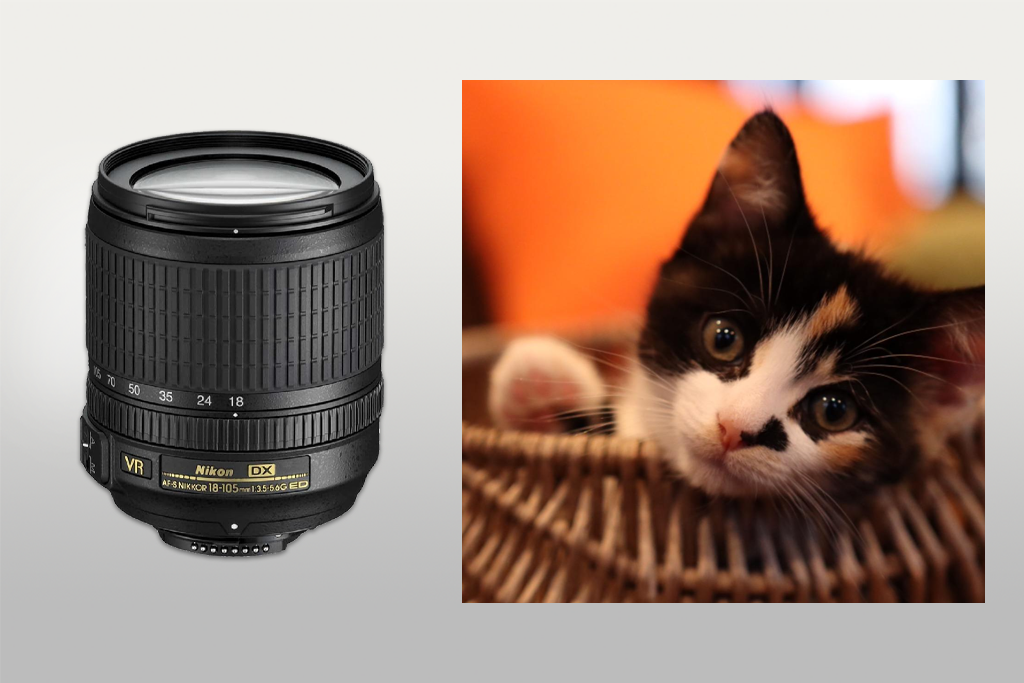
Lens Type: Standard | Focal length: 18-105mm | Aperture: f/3.5 to f/5.6 | VR: Yes | Weight: 420g
Best for: Beginner photographers, general everyday shooting, travel. It is a smaller and lighter version of the 18-140mm lens for D7100, making it a great walk-around option.
I tried this Nikon D7100 lens for city photos, portraits, indoor events, and outdoor trips. It seemed compact and easy to use, and its zoom range lets you go from wide scenes to medium zoom quickly without swapping lenses. You can also focus quite close (about 1.48 feet), which makes capturing creative close-up shots fun and simple.
The Vibration Reduction (VR) worked very well, letting me take handheld shots in dim light with less blur. Although sometimes autofocus took a bit longer in very dark places, it was mostly fast and accurate. The color quality was natural and even, helped by Nikon’s Super Integrated Coating, and lens flare was low even when shooting toward bright light.
There were a few small issues: the image got slightly softer at the far end of the zoom (around 95–105mm), and there was a bit of barrel distortion at 18mm, which is easy to fix in-camera or afterward. When Vadym was testing the lens, he focused on how the lens worked in real situations. He said it’s great for both travel and portraits and liked that it’s light and well-balanced on the D7100, making it easy to carry for long shoots. He also noticed that while the center of the image was very sharp, the edges were a bit softer at the wide end, which is normal for a Nikon standard lens of this type.
Amazon: 200+ bought in the past month
B&H: 600+ sold in the past year
Adorama: 300+ sold in the past year
Best Buy: 200+ sold in the past year

Lens Type: Wide-angle zoom | Focal length: 18-35mm | Aperture: f/1.8| VR: No | Weight: 810g
Best for: Landscapes, portraits, close-ups, casual photography, low-light shooting. Thanks to the f/1.8 aperture, you get excellent bokeh and shallow depth of field, rare for a zoom lens.
When I first used the Sigma 18-35mm F1.8 Art DC HSM on my Nikon D7100, I immediately noticed how strong and well-built it felt. I tested it on many types of shoots – wide outdoor landscapes and close-up portraits – to see if it could perform like a prime lens. From the start, the F1.8 aperture stood out, letting in lots of light and creating smooth, soft backgrounds that made the subject pop.
The photos I got with this Sigma lens were extremely sharp, with clear detail from edge to edge and very natural colors. This made it great for portraits, product photography, and everyday use. The zoom and focus rings worked smoothly, which made the lens easy to handle, though its heavier weight meant I had to hold it more carefully during long shoots. Since the lens doesn’t have VR, handheld video in low light was harder, so I had to use a tripod or keep my hands steadier. There was a bit of vignetting at the corners when zoomed out to 18mm, but it was simple to fix later in editing.
When Vadym tested this lens for the Nikon D7100, he focused on how it worked in real situations. He liked its sharpness across the entire frame and said it performed very well for both portraits and landscapes. He also mentioned that the HSM autofocus was quiet and accurate, which made it useful for video. The only downsides he noted were the heavy weight, which can make handheld shooting tiring, and the lack of VR, which means video in low light needs extra support or stabilization.
Amazon: 1K+ bought in the past month
eBay: 100+ sold in the past year
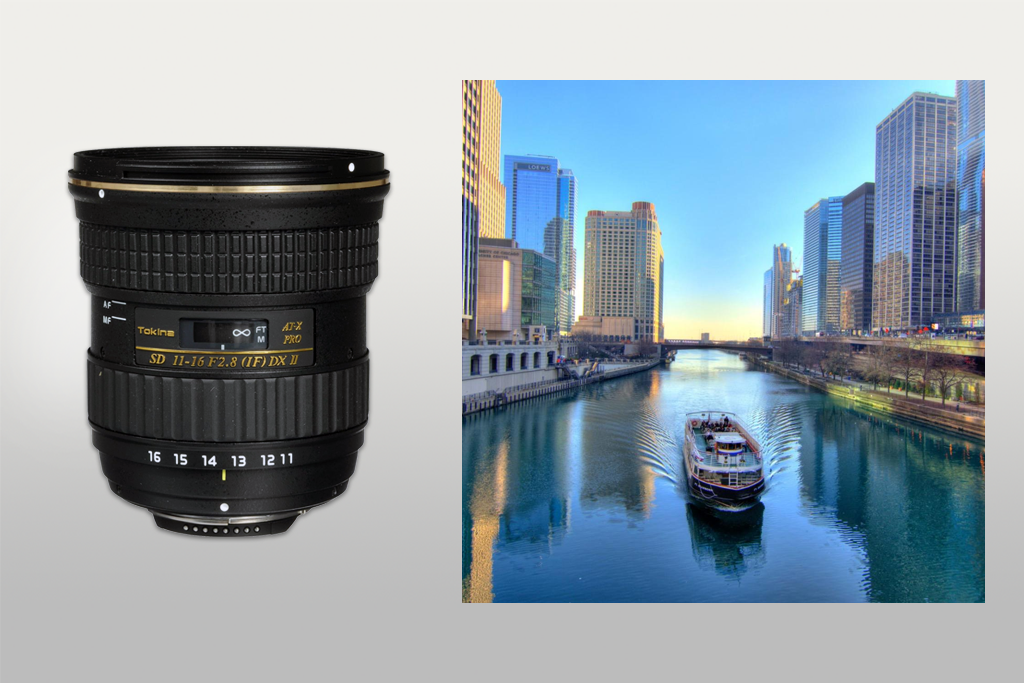
Lens Type: Wide-angle zoom | Focal length: 11-16mm | Aperture: f/2.8 | VR: No | Weight: 550g
Best for: Landscapes, cityscapes, real estate, astrophotography, interiors. The wide 11–16mm range captures expansive scenes, and f/2.8 is useful for night skies.
When shooting cities or room interiors with Tokina 11-16mm f/2.8 AT-X116 on my Nikon D7100, I could include a lot more of the scene without stepping back. For landscapes, the lens gave me very sharp and detailed images, especially at settings between f/5.6 and f/8. At night, the bright f/2.8 aperture helped me take clear pictures of stars without needing to raise the ISO too much.
What I liked most about this lens for landscape photography was how strong and solid it felt – it felt like a professional lens. The one-touch clutch focus system made it easy to switch between autofocus and manual focus. However, the zoom range (11-16mm) is quite short, so it’s not as flexible as other lenses. In very bright light, I noticed a bit of flare and ghosting, especially when shooting toward the sun.
Vadym tested this Nikon D7100 lens for travel and architecture. He liked how well it kept straight lines looking natural, which reduced the need for fixing distortion later. He also mentioned that the colors looked rich, and the contrast was nice, even in tricky lighting. On the downside, he noticed some chromatic aberration in high-contrast areas, and while the autofocus was accurate, it wasn’t the quickest.
Amazon: 1K+ bought in the past month
Adorama: 200+ sold in the past year
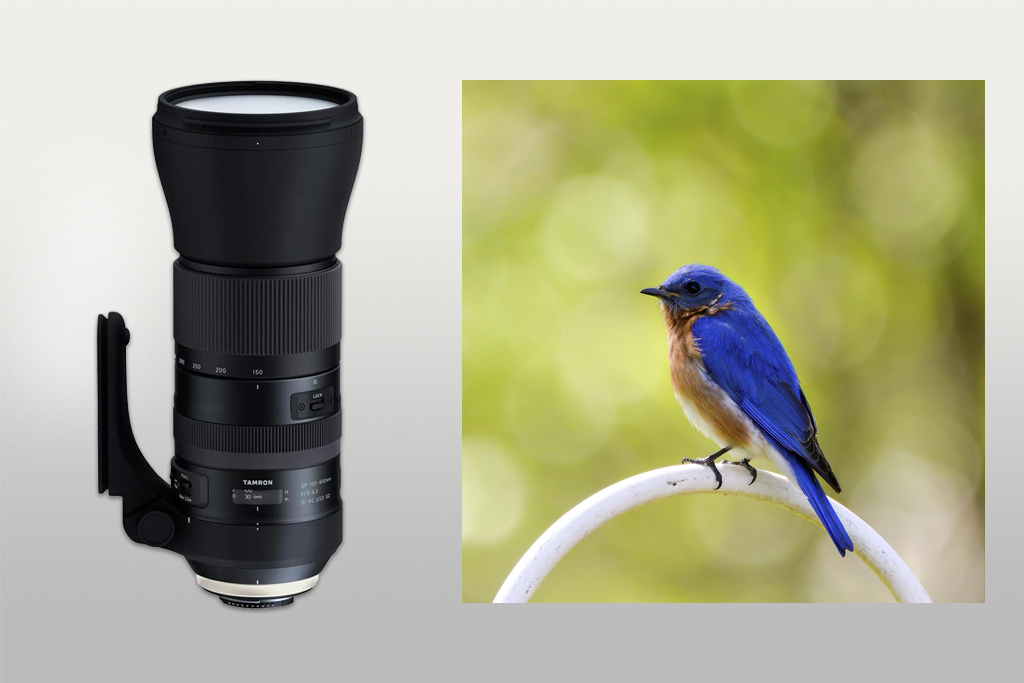
Lens Type: Telephoto zoom | Focal length: 150–600mm | Aperture: f/5–6.3 | VR: Yes | Weight: 2010 g
Best for: Wildlife, birds, sports, long-distance action. Extremely long reach up to 600mm makes it ideal for subjects you can’t physically get close to.
I’ve tested many lenses for the Nikon D7100, but the Tamron 150–600mm G2 is the one that truly changes the camera into a great tool for wildlife and sports photography. The first thing I noticed was its large size and weight, but this lens for wildlife photography feels well-balanced, especially when using a monopod. For nature, that long reach is amazing: at 600mm, I captured clear and detailed photos of the birds I could barely see from the ground.
What stood out most about this lens was its VC feature. Even when shooting handheld at 600mm with a slow shutter speed (around 1/100 second), my photos still came out sharp, which was surprising. The autofocus worked fast in bright light, and when I used the focus limiter, it tracked small moving subjects more easily. However, focusing on fast-moving subjects can still be hard with the D7100’s older AF system, and carrying this lens for long hours can be tiring.
Vadym tested this lens for sports photography. He liked the flex zoom lock, which lets you lock the zoom at any distance, so you don't get zoom creep when the lens is pointing downward. He also mentioned that the tripod collar design made it comfortable to move the camera smoothly while tracking motion. His main complaints were that autofocus slowed down a bit in low light and that the manual focus ring didn’t allow for very fine adjustments because of its short rotation range.
Amazon: 500+ bought in the past month
B&H: 400+ sold in the past year
Adorama: 200+ sold in the past year
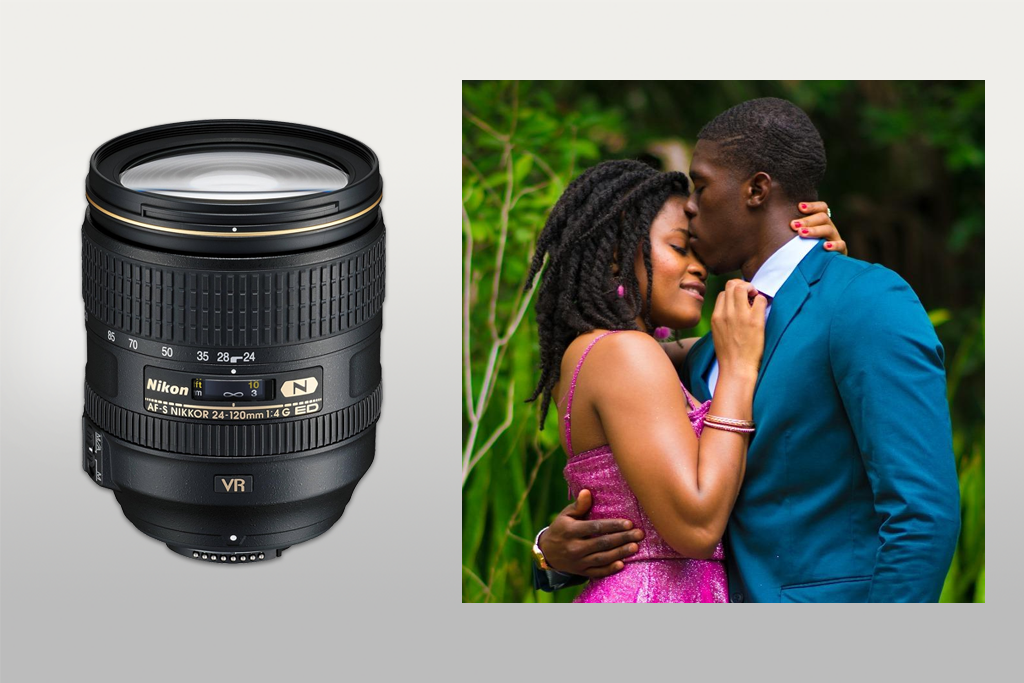
Lens Type: Standard zoom | Focal length: 24-120mm | Aperture: f/1.4 | VR: Yes | Weight: 710g
Best for: Portraits, events, travel, weddings. Constant f/4 aperture is useful for consistent exposure across zoom range. On the D7100, it’s less wide than on full-frame, but still a versatile event lens.
Mounted on my Nikon D7100, the 24-120mm f/4G ED VR felt like a strong all-purpose lens from the start. The 5x zoom range made it great for many types of photography, and the steady f/4 aperture meant I didn’t have to adjust exposure every time I zoomed in or out. I tested it during a portrait photoshoot, a short city photo walk, and an indoor event to see how it performed in different lighting.
What I liked most was the color quality – Nikon’s Nano Crystal Coat kept the colors and contrast strong, even when shooting toward bright light. The Vibration Reduction system also worked well, helping me take handheld shots at slower shutter speeds than usual. On the downside, this lens for portraits feels a bit heavy after long use, and while the background blur at f/4 is smooth, it’s not as soft as you get with faster prime lenses for Nikon D7100.
Vadym used this lens during a wedding shoot. He liked how quickly it focused during moving shots (for example, when the bride and groom walked down the aisle). He also appreciated how easy it was to go from wide group photos at 24mm to close-up couple portraits at 120mm without switching lenses. However, he did notice that at the wider end, the edges of the photos weren’t as sharp as the center, especially when shooting with the aperture wide open.
Amazon: 500+ bought in the past month
B&H: 600+ sold in the past year
Adorama: 400+ sold in the past year
Best Buy: 400+ sold in the past year
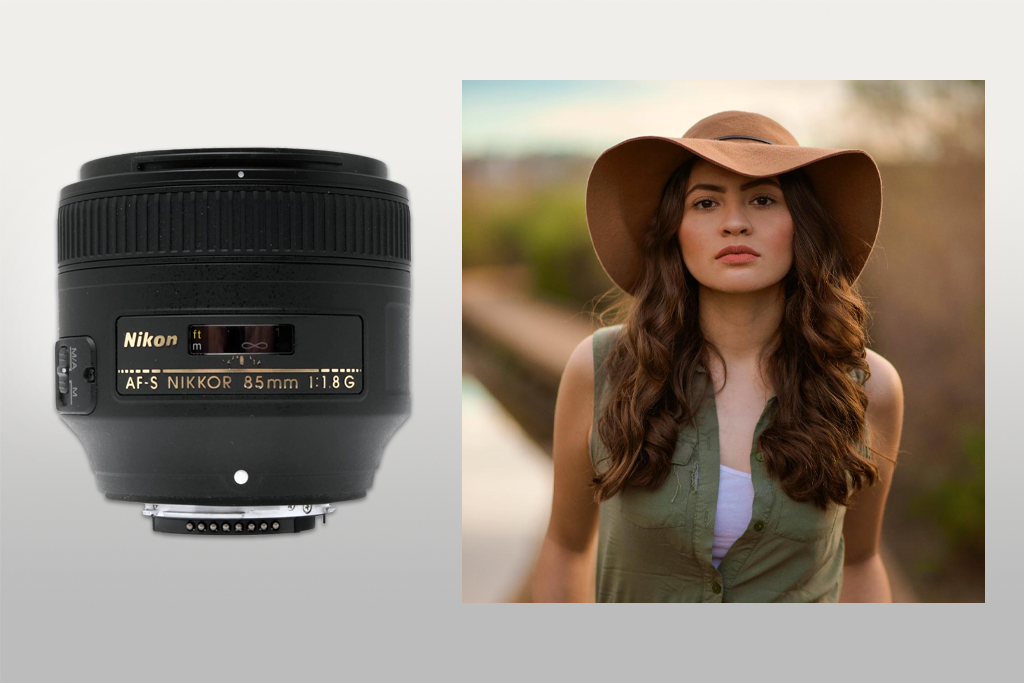
Lens Type: Telephoto prime | Focal length: 85mm | Aperture: f/1.8 | VR: No | Weight: 350g
Best for: Portraits, headshots, and subject isolation. On the D7100 it gives ~127mm equivalent focal length, perfect for flattering compression and creamy bokeh.
When I tested the Nikon AF-S NIKKOR 85mm f/1.8G, I found out why it’s one of the most popular portrait lenses. Outside, the Silent Wave Motor focused fast and accurately, and indoors, the wide f/1.8 aperture created soft, beautiful backgrounds that make portraits look professional.
What impressed me most about this prime lens was its sharpness and how naturally it captured skin tones, even when the aperture was wide open. It’s also light, which makes it easy to use during long photo sessions. However, at f/1.8, the focus can shift slightly if your subject moves, and since it’s a prime lens, you’ll need to move around to change framing, which can be less convenient at events.
Vadym also tested this telephoto lens for Nikon D7100 and liked its strong performance and reliability for low-light and portrait photography. He did notice that sometimes the bokeh can look a bit messy when shooting in front of patterned or busy backgrounds. Nonetheless, this remains one of the best and most dependable lenses for portraits on the Nikon D7100.
Amazon: 400+ bought in the past month
eBay: 100+ sold in the past year

Lens Type: Macro/Telephoto prime | Focal length: 105mm | Aperture: f/2.8| VR: Yes | Weight: 720g
Best for: Macro (1:1 close-ups), product photography, flowers, insects. Doubles as a sharp portrait lens thanks to its smooth bokeh and stabilization (VR).
When I used the Nikon AF-S VR Micro-NIKKOR 105mm f/2.8G, it felt like adding a microscope to my camera setup. I tested this low-light lens for Nikon on small items like jewelry and flowers, and the 1:1 magnification gave me sharp, detailed images. Also, the VR system helped me shoot handheld at slower shutter speeds without getting blurry pictures.
When trying this Nikon D7100 lens for portraits, I liked how the f/2.8 aperture kept the person’s eyes sharp while gently blurring the background, creating a natural and soft look. The working distance was also great for macro shots: with this macro lens for Nikon, I didn’t have to get too close to the subject, so I didn’t block the light or cast shadows. The downsides I noticed were that it’s not very light, and focusing at very close range can be a bit slower than with smaller prime lenses.
Vadym mentioned that this lens balances macro precision and portrait use very well. He liked how it performs in low light and that the VR made it easier to take close-up photos without always needing a tripod. He also noted that while the bokeh usually looks smooth, it can appear slightly busy in backgrounds with a lot of detail.
My colleague from FixThePhoto and I tested many different lenses for the Nikon D7100, covering all kinds of photography styles:
Not all of these lenses made it into our final list. We only chose the best lenses for the Nikon D7100 based on how they performed during testing. Some lenses we already had in our studio, and others we borrowed from Lensrentals to make sure our testing covered a wide range of options.
Every lens we tested worked perfectly with the Nikon D7100 and its Nikon F-mount, which means the camera could use autofocus, metering, and vibration reduction when available. We focused on DX and FX lenses that operate smoothly in DX crop mode on the D7100.
Here’s how we tested each lens:
1. Image Quality
2. Autofocus Performance
3. Bokeh and Background Blur
4. Build and Handling
5. Versatility and Real-World Use
6. Final Impressions
By following this clear testing process and focusing on lenses that fully support the D7100’s mount system, we made sure that our recommendations are based on both technical performance and practical use. This way, photographers using this Nikon photography camera can find lenses that work well for their style, skill level, and budget.